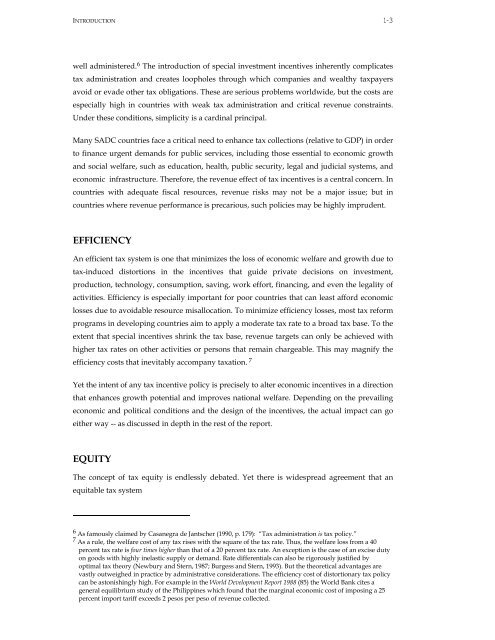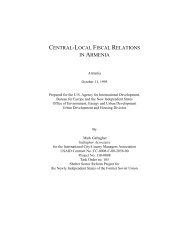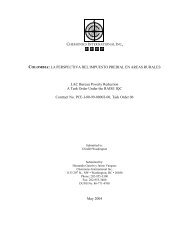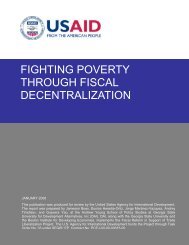Effectiveness and Economic Impact of Tax Incentives in the SADC ...
Effectiveness and Economic Impact of Tax Incentives in the SADC ...
Effectiveness and Economic Impact of Tax Incentives in the SADC ...
Create successful ePaper yourself
Turn your PDF publications into a flip-book with our unique Google optimized e-Paper software.
INTRODUCTION 1-3<br />
well adm<strong>in</strong>istered. 6 The <strong>in</strong>troduction <strong>of</strong> special <strong>in</strong>vestment <strong>in</strong>centives <strong>in</strong>herently complicates<br />
tax adm<strong>in</strong>istration <strong>and</strong> creates loopholes through which companies <strong>and</strong> wealthy taxpayers<br />
avoid or evade o<strong>the</strong>r tax obligations. These are serious problems worldwide, but <strong>the</strong> costs are<br />
especially high <strong>in</strong> countries with weak tax adm<strong>in</strong>istration <strong>and</strong> critical revenue constra<strong>in</strong>ts.<br />
Under <strong>the</strong>se conditions, simplicity is a card<strong>in</strong>al pr<strong>in</strong>cipal.<br />
Many <strong>SADC</strong> countries face a critical need to enhance tax collections (relative to GDP) <strong>in</strong> order<br />
to f<strong>in</strong>ance urgent dem<strong>and</strong>s for public services, <strong>in</strong>clud<strong>in</strong>g those essential to economic growth<br />
<strong>and</strong> social welfare, such as education, health, public security, legal <strong>and</strong> judicial systems, <strong>and</strong><br />
economic <strong>in</strong>frastructure. Therefore, <strong>the</strong> revenue effect <strong>of</strong> tax <strong>in</strong>centives is a central concern. In<br />
countries with adequate fiscal resources, revenue risks may not be a major issue; but <strong>in</strong><br />
countries where revenue performance is precarious, such policies may be highly imprudent.<br />
EFFICIENCY<br />
An efficient tax system is one that m<strong>in</strong>imizes <strong>the</strong> loss <strong>of</strong> economic welfare <strong>and</strong> growth due to<br />
tax-<strong>in</strong>duced distortions <strong>in</strong> <strong>the</strong> <strong>in</strong>centives that guide private decisions on <strong>in</strong>vestment,<br />
production, technology, consumption, sav<strong>in</strong>g, work effort, f<strong>in</strong>anc<strong>in</strong>g, <strong>and</strong> even <strong>the</strong> legality <strong>of</strong><br />
activities. Efficiency is especially important for poor countries that can least afford economic<br />
losses due to avoidable resource misallocation. To m<strong>in</strong>imize efficiency losses, most tax reform<br />
programs <strong>in</strong> develop<strong>in</strong>g countries aim to apply a moderate tax rate to a broad tax base. To <strong>the</strong><br />
extent that special <strong>in</strong>centives shr<strong>in</strong>k <strong>the</strong> tax base, revenue targets can only be achieved with<br />
higher tax rates on o<strong>the</strong>r activities or persons that rema<strong>in</strong> chargeable. This may magnify <strong>the</strong><br />
efficiency costs that <strong>in</strong>evitably accompany taxation. 7<br />
Yet <strong>the</strong> <strong>in</strong>tent <strong>of</strong> any tax <strong>in</strong>centive policy is precisely to alter economic <strong>in</strong>centives <strong>in</strong> a direction<br />
that enhances growth potential <strong>and</strong> improves national welfare. Depend<strong>in</strong>g on <strong>the</strong> prevail<strong>in</strong>g<br />
economic <strong>and</strong> political conditions <strong>and</strong> <strong>the</strong> design <strong>of</strong> <strong>the</strong> <strong>in</strong>centives, <strong>the</strong> actual impact can go<br />
ei<strong>the</strong>r way -- as discussed <strong>in</strong> depth <strong>in</strong> <strong>the</strong> rest <strong>of</strong> <strong>the</strong> report.<br />
EQUITY<br />
The concept <strong>of</strong> tax equity is endlessly debated. Yet <strong>the</strong>re is widespread agreement that an<br />
equitable tax system<br />
6 As famously claimed by Casanegra de Jantscher (1990, p. 179): “<strong>Tax</strong> adm<strong>in</strong>istration is tax policy.”<br />
7 As a rule, <strong>the</strong> welfare cost <strong>of</strong> any tax rises with <strong>the</strong> square <strong>of</strong> <strong>the</strong> tax rate. Thus, <strong>the</strong> welfare loss from a 40<br />
percent tax rate is four times higher than that <strong>of</strong> a 20 percent tax rate. An exception is <strong>the</strong> case <strong>of</strong> an excise duty<br />
on goods with highly <strong>in</strong>elastic supply or dem<strong>and</strong>. Rate differentials can also be rigorously justified by<br />
optimal tax <strong>the</strong>ory (Newbury <strong>and</strong> Stern, 1987; Burgess <strong>and</strong> Stern, 1993). But <strong>the</strong> <strong>the</strong>oretical advantages are<br />
vastly outweighed <strong>in</strong> practice by adm<strong>in</strong>istrative considerations. The efficiency cost <strong>of</strong> distortionary tax policy<br />
can be astonish<strong>in</strong>gly high. For example <strong>in</strong> <strong>the</strong> World Development Report 1988 (85) <strong>the</strong> World Bank cites a<br />
general equilibrium study <strong>of</strong> <strong>the</strong> Philipp<strong>in</strong>es which found that <strong>the</strong> marg<strong>in</strong>al economic cost <strong>of</strong> impos<strong>in</strong>g a 25<br />
percent import tariff exceeds 2 pesos per peso <strong>of</strong> revenue collected.











